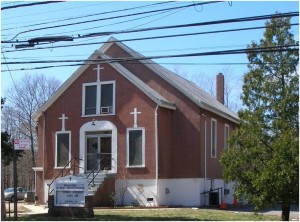Four 19th century buildings in Staten Island’s Sandy Ground, one of the first communities settled by freed slaves, considered. On August 10, 2010, Landmarks heard testimony on the potential designations of four buildings located in Staten Island’s Sandy Ground community, one of the country’s oldest communities settled by freed slaves. The buildings date to the 19th century and include the Rossville AME Zion Church located at 584 Bloomingdale Road, two cottages at 565 and 569 Bloomingdale Road, and the Coleman House located at 1482 Woodrow Road.
Located on Staten Island’s south shore, freedmen settled Sandy Ground after New York abolished slavery in 1827. Soon after, free blacks from the Chesapeake Bay region traveled to the community to pursue their trade as oystermen in a place where they could own and captain their own boats. The community persisted after the oyster beds were closed due to pollution in 1916, and descendants of the original settlers reside in the area to this day. The City recently rezoned the area, and the Rossville AME church’s leadership opposed the action due to concerns that it would prevent the church’s planned senior citizen housing project. 7 CityLand 5 (Feb. 15, 2010).
In 1897, Andrew Adams built the vernacular Rossville AME Zion Church for a congregation that had incorporated in 1850. Virginia-born clergyman William H. Pitts purchased the property, and served as the church’s first pastor.
Landmarks designated the church’s cemetery in 1985. The church lost its steeple, and its sides have been reclad with faux brick. However, the structure retains its essential form, fenestration, porch, and stoop. At the hearing, Yvonne Taylor, the chairperson of the church’s board of trustees, spoke in favor of designation. Taylor noted that the church served as the “center of community and religious life for the free African-American community” and that it will soon celebrate 160 years of service. The Society for the Architecture of the City’s Christabel Gough strongly supported designation characterizing the church as the “most widely visible emblem of Sandy Ground.” Landmarks considered the 565 and 569 Bloomingdale Road Houses together as an individual landmark. The homes were built simultaneously in the 1880s by an unknown architect as rental properties for Robert Mersereau. Vernacular in style, the nearly identical structures are of a type known as “baymen’s cottages” featuring peaked roofs, central chimneys, and shallow stoops and porches. A 1963 fire damaged many structures in the area, but the cottages survived as a rare example of their types.
The Preservation League of Staten Island’s John Kilcullen supported designation, stating that the buildings were important to “preserve a sense of place that is rapidly being lost.” The Historic District Council’s Ed Kirkland testified that the two houses were survivors of a group of three and retained most of their original fabric.
The Coleman House was built in the 1860s for the Rossville AME church’s leader and his wife, the Reverend Isaac Coleman and Rebecca Gray Coleman. The Structure’s oldest portion is two stories tall with three window bays. An east and west wing and a rear one-story addition were added before 1940, according to Landmarks staff.
David Mitchell, a former resident of the house and partial owner of the property, testified that the home was currently operating as a two-family rental property. Mitchell said that certain “legal and liability issues,” including outstanding Buildings violations, should be resolved before landmarking proceeded. Yvonne Taylor, a descendant of Rebecca Gray Coleman, supported designation and described how the building evolved from a simple cottage to a thirteen-room house as the Coleman family expanded.
No date has been set for voting on the designations.
LPC: Rossville AME Zion Church, 584 Bloomingdale Rd., Staten Island (LP-2416); 565 and 569 Bloomingdale Road House, 565, 569 Bloomingdale Rd., Staten Island (LP-2415); Isaac and Rebecca Gray Coleman House, 1482 Woodrow Rd., Staten Island (LP-2414) (Aug. 10, 2010).


